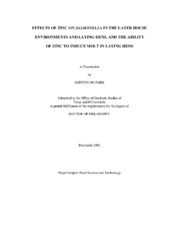| dc.description.abstract | There is increasing interest in developing methods to detect and identify Salmonella, to eliminate or reduce the risk of contamination of shell eggs, and to retain the economic advantages of induced molting without increasing the risk of Salmonella enteritidis infection. S. enteritidis and S. typhimurium are the most common serotypes among 2449 known serotypes of the Salmonella, and are the causes of most egg- related foodborne salmonellosis in humans in the U. S. These two species are also responsible for environmental contamination and the incidence of infections.
Therefore, this study was conducted in three phases consisting of ten in vivo and in vitro experiments. This study investigated the effects of zinc on Salmonella growth and survivability in poultry environments, and its ability to induce a molt in single comb white leghorn hens. In part, the antibacterial properties of zinc may reduce environmental contamination in a poultry house by interrupting airborne routes. The first phase involved detecting airborne bacteria by aerosol sampling methods, and then screening any Salmonella mutant (s) that survived desiccation by transposon footprinting. The second phase examined, in vitro, the addition of zinc on the growth kinetics of Salmonella under aerobic or anaerobic conditions, the effects of combinating zinc and acidic conditions on the growth kinetics of Salmonella in vitro under aerobic or anaerobic conditions, and the effects of zinc amended feed on the survival of a dry inoculum of Salmonella. The third phase investigated the ability of zinc propionate, as an alternative salt form of zinc, to induce molt in laying hens, the influence of zinc acetate and zinc propionate on gastrointestinal tract fermentation, and susceptibility of laying hens to S. enteritidis during an induced molt, and the comparison of digestive microbial crop and cecal communities among molted hens fed by either zinc acetate or zinc propionate amended molting diets with hens undergoing feed withdrawal or full fed nonmolted hens using molecular-based denaturing gradient gel electrophoresis. | en |


